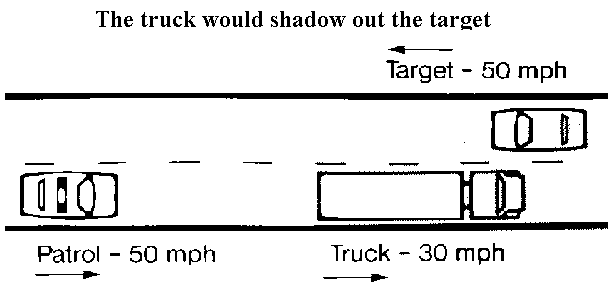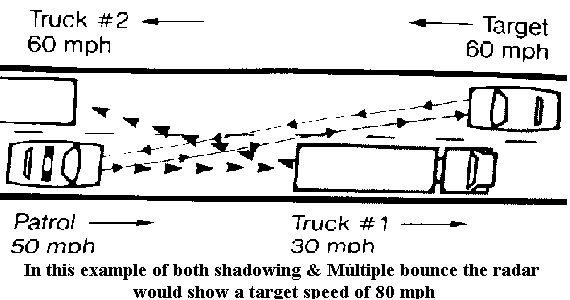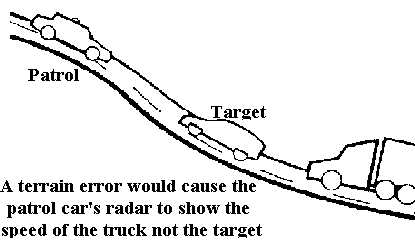
Traffic Radar Reliability
The use of police traffic radar is so widespread that we naturally assume the technology is reliable. After all, if there were questions about radar's accuracy, would the courts process speeding violations with such assembly-line efficiency?
We tend to take the answer to this question on faith. That may be unfortunate, because radar makes mistakes. Lots of them. Some experts estimate that 10-20 percent of all radar-backed speeding tickets are issued in error; and in the case of radar that is operated from a moving police vehicle the number of bad tickets may be as high as 30 percent!
This Brochure [a print version of this info. is available from RADAR] is intended to familiarize the reader with some of the most common radar errors. Our Hope is that more people will realize that traffic radar is not infallible, and will challenge speeding tickets they know they don't deserve. The end result will be a greater effort by the radar industry to build better products, and by law enforcement to use this technology more responsibly.
Two Kinds of Radar
To understand how radar makes mistakes, it is first necessary to know how radar works. Basically, there are two kinds of radar - traffic radar, and rotating- antenna radar. The latter group includes weather, airport, military and other types of commercial radar. By contrast, police traffic radar uses a stationary single antenna that points in a single direction; does not transmit a modulated signal; and does not use a cathode ray screen to display information.
These three differences are extremely important.
All radar works by transmitting a microwave beam on a specific frequency. Targets that are struck by the beam reflect microwave energy to the antenna, a computer analyzes any changes in frequency and displays this information. Military-commercial types of radar use a sweeping , modulated beam which provides details about an objects' shape, speed, and direction for the operator. By contrast, the stationary beam and digital readout of police traffic radar yield only one piece of information: how fast a target is approaching or receding from the radar.
Police traffic radar doesn't tell its operator which object it is measuring or the direction that the object is traveling, limitations that compel manufacturers to build in certain electronic compromises.
Radar Gone Bad
In early 1979, a Miami television station showed viewers a radar gun clocking a palm tree at 86 mph and a house at 28 mph. In the first instance, the reading was caused by panning the radar antenna and in the second, the radar unit was measuring the fan motor in the patrol car. The TV report prompted a court case that brought radar errors national attention.
A year later the National Bureau of Standards tested the six most popular police radar models, finding that all produced false speed readings in the presence of CB or police radios. Each of the two-piece units produced panning errors like the one that caught the Miami house apparently moving at 28 mph. All of the moving radar units were subject to "shadowing," causing some of the patrol car's speed to be added to that of the target vehicle (Federal Register, Vol. 46, No. 5, Jan. 8, 1981).
When the International Association of Chiefs of Police tested 24 radar models in 1983 and '84, the results showed that nearly all of the units were affected by temperature variation, five failed accuracy tests, four had unacceptably wide beam widths and three tended to provide inaccurate readings due to nearby police or CB radios.
Federal performance standards were proposed but never adopted during the Reagan administration. Instead, radar manufacturers promised to police their own ranks. From out perspective, things haven't improved. Police radar is as error prone today as ever, particularly with the widespread use of radar in the instant-on mode.
And the effectiveness of the manufacturers' self-policing policy came to light recently (3/89) when it was revealed that one radar maker sold thousands of units bearing fraudulent Federal Communications Commission certification.
Some of radar's shortcomings are readily apparent. Beam Width is one. Think of a radar beam as a cone - narrow at the radar antenna and widening as it heads for the horizon. Even the narrowest of radar beams - 11 degrees - is 38 feet wide when 200 feet down the road and 57 feet wide at 300 feet away. Some radar units transmit a beam as wide as 24 degrees. By the time a radar beam is several hundred feet from a patrol car, the microwaves are blanketing an area as wide as an expressway.
Now picture that expressway full of cars and trucks, and remember that traffic radar can't tell its operator which vehicle it is monitoring, or whether the target is approaching or traveling away from the police car. You quickly understand how great the potential is for misidentification.
Let's throw in another twist or two. Even though police radar is based on the Doppler Principle, most units do not interpret the Doppler shift itself. Rather, they process the frequency of the signal and use its analog to represent target speeds. Known as phase-lock loop, or PPL, this processing can lock onto the wrong target, double or triple low speed readings, or produce "ghost" readings. Other types of common radar errors are:
1.Radio or Microwave Interference can come in a variety of forms, both natural and man-made, but they have one thing in common - they produce a false or incorrect reading on the radar unit's display. Common sources of electromagnetic interference include airport radar; microwave transmissions; transmissions of CB, ham, VHF/UHF, and cellular two-way radio/ telephones, including police and business radios; faulty sparkplug wires; mercury vapor and neon lights; high-tension powerlines; and high voltage power substations. The radio energy from these sources can overload or confuse the sensitive circuits in a radar gun
2. Mechanical Interference is any moving object, other than the target vehicle, that can produce a false or incorrect radar reading. The most common sources are vibrating or rotating signs near the roadway; fan blades moving inside or outside the patrol car (air conditioner, heater, defroster or engine fan); another moving vehicle that reflects radar waves better than the target vehicle; and multiple targets in the main radar beam causing multiple reflections of nearly equal strength and making the display read, high, low, or completely blank.
3. Multi-Path Beam Cancellation occurs when the radar signal returning directly to the radar gun from the target vehicle is canceled by a secondary reflected signal. This cancellation can occur while the target remains in plain view of the operator. The display may blank or suddenly switch to another vehicle beside or behind the original target until the cancellation ceases.
4. Panning occurs when the radar beam accidentally sweeps past the counting/computing unit. This can happen only to a two-piece radar unit. The radio energy from the antenna portion overloads or confuses the counting/computing circuitry.
5. Shadowing is a problem that occurs only with moving radar, and plagues all moving radar. The radar locks onto a large moving object in front of the patrol car instead of the passing terrain and computes the difference in speeds between the two vehicles as lower than the actual patrol speed. Consequently , the radar adds the remainder of the patrol speed to the target's speed, producing an erroneously high reading.

6. Batching is caused by time lags in the computing of speeds by some types of moving radar. If the patrol car rapidly accelerates or decelerates while measuring target speeds, the display can read higher or lower than the actual speed.
7. Stationary Cosine Error is a problem which occurs when the radar unit is not taking its readings from vehicles that are directly ahead of or behind the police vehicle - there is an angle between the radar unit and its target , and it is the cosine of this angle (remember your high school trigonometry?) that determines the magnitude of the error. With stationary radar, the greater the angle between the radar and the roadway, the lower the indicated speed. This error does not become significant until the angle to the roadway exceeds 10 degrees. Fortunately, with stationary radar, the cosine error is in favor of the motorist.
8. Moving Cosine Errors can result in readings that are either higher or lower than the target's actual speed. More often, the erroneous reading is not in the motorist's favor.
The moving radar can lock onto a large object to the side of the roadway instead of the ground and, due to the cosine error, compute a lower-than-actual speed for the patrol car. The remainder of the patrol speed is added to the target's speed. Similarly, if the radar is not carefully aligned within 10 degrees of the patrol car's direction of travel, it will compute a lower-than-actual patrol speed. Again, the remainder is added to the target speed.
On the other hand, if moving radar is used to measure across a wide median, as on an interstate highway, the large angle can cause a lower-than-actual target speed to be displayed , assuming the patrol speed is correctly computed.
9. Multiple Bounce Errors sometimes happen when there are multiple moving targets within the main beam, causing several reflected of near-equal strengths but varying frequencies to arrive at the radar gun's antenna. Depending on the gun, the display may switch from one speed reading to another, it may show a combination of the reflections, or it may blank out.

Overpasses on freeways are commonly the source of multiple bounce errors. The error observed most often is a double bounce which causes the patrol car's speed to be indicated in both the target display and the patrol display. Sometimes the overpass bounce will involve a large, slower-moving vehicle near that patrol car, causing the target speed to be displayed as the speed of the patrol plus that of the slower vehicle.
In another multiple bounce case, the signal can be reflected more than once, by two moving objects, and the total Doppler shift will be displayed as a higher- than-actual speed.
10. Terrain Error takes place when hilly or curved roadways affect radar's ability to process information. When the patrol car is at the crest of a hill, it is very easy for radar to overshoot the nearest vehicle and instead take a reading from a vehicle on the next hill. Because traffic radar is "direction blind," differences in reflectivity may cause instant-on readings to display the speed of a receding vehicle rather than of an approaching vehicle. So that vehicle "on the next hill" need not even be traveling the same direction as the supposed target vehicle.

Pulse Problems
The careful, well-trained operator can spot many of these radar errors when they occur. By constantly monitoring traffic speeds, he will notice the oddball reading or the onset of some other problem. This ongoing record of vehicle speeds and possible sources of interference is known as a traffic or tracking history.
With no traffic or tracking history, it is difficult for the operator to know which vehicle produced a particular speed reading, or whether there is some sort of interference present. When radar is used in the instant-on mode - short bursts of one or two seconds duration - the potential is great for these errors being misinterpreted as actual speed readings. Particularly troublesome are problems involving target identification, and the first three types of errors mentioned above (radio or microwave interference, mechanical interference and multi-path cancellation).
One Pennsylvania driver tells of following an Ohio Highway Patrol car on a rolling interstate highway. Each time the police cruiser neared the top of a hill, the trooper would flip on his radar (setting off the Pennsylvanian's radar detector). After cresting the hill and taking a brief reading of whatever was on the other side, the officer would shut off his radar again. "This went on for several miles," the driver explained, "until the police car did a U-turn in the median, presumably to got trolling in the opposite direction."
As we pointed out earlier, instant-on radar has only one purpose - to try to confound radar detector users. But the drawbacks are many. In addition to increasing the likelihood that radar errors will go unnoticed, instant-on radar also defeats one of radar's most useful features. Studies have shown that highly visible police patrols are most effective when it comes to encouraging drivers to obey traffic laws; radar and radar detectors increase the "visibility" of a patrol car, slowing traffic over a wider area.
But despite such evidence, instant-on radar is growing in popularity. To many officers see radar detectors as a threat to their authority, rather than an ally in helping encourage motorists to obey the rules of the road.
Protecting Yourself From Radar's Mistakes
It is significant to point out that traffic radar is not privileged communication; it is electronic surveillance, and citizens have a right to know when government is monitoring their actions, especially when that monitoring is being conducted with an error prone technology.
Radar detectors are little more than radio receivers tuned to the same frequencies used by police radar. They alert the motorist to the fact that radar is in use nearby, which raises his driving and prompts him to pay closer attention to his surroundings.
Despite the accusations of critics, there is nothing criminal or immoral about radar detector use (it is illegal in only three places in the nation) and one survey found that detector users had far fewer accidents on a per-mile basis than the average driver.
Beyond that is the problem of using radar to generate revenue rather than improve safety. Many municipalities employ radar as a form of highway tax paid by unwary travelers. Again, a radar detector can help a motorist avoid or defeat such a ticket.
Standing up for Your Rights
If you are a victim of an undeserving speeding citation - or you don't want to become a victim - the Radio Association Defending Airwave Rights, Inc. (RADAR) provides assistance in several forms.
First, RADAR is involved on the legislative, regulatory and legal fronts, preserving the rights of motorists to use radar detectors and fighting the abuses of traffic radar. The association offers low-cost associate membership to motorists who want to support this effort. Members also have access to our attorney-referral service that can put you in touch with lawyers who specialize in defending drivers who have been cited undeservedly.
Finally, RADAR offers a variety of publications and videos intended to help you understand traffic radar and its shortcomings, and to keep yourself from winding up holding the expensive end of a bad ticket.
RADAR, its agents, employees, officers, Board of Trustees or assigns, is/are not responsible for the accuracy of the contents of the information supplied herein and make(s) no representation(s) in any regard as to the same. No person or entity is authorized by RADAR, its agents, employees, officers, Board of Trustees or assigns, does not warrant or guarantee this information to any extent or for any purpose whatsoever.